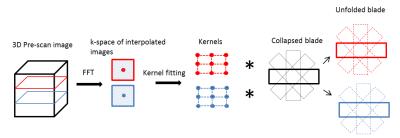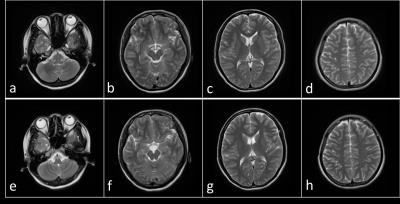3842
Slice-GRAPPA calibration using pre-scan data and application to simultaneous multi-slice PROPELLER1Siemens Shenzhen Magnetic Resonance Ltd., Shenzhen, People's Republic of China
Synopsis
In simultaneous multi-slice imaging technique, the kernels used for unfolding the collapsed slices are estimated using integrated or separated reference scans, which require additional scan time. In this work a slice-GRAPPA calibration method utilizing the pre-scan data is developed to save the time for acquiring training data. This method has been applied to slice accelerated PROPELLER sequence. The result shows that the proposed method can correctly fit the SG kernel and reconstruct the slice undersampled images.
PURPOSE
Simultaneous multi-slice (SMS) [1] technique allows for a dramatic acceleration in MRI, especially in multi-repetition applications, e.g., BOLD fMRI and diffusion MRI, where the first repetition is used to acquire the full slice data and employed as the auto calibration signal (ACS). In clinical MRI, however, most applications contain only one repetition and thus additional ACS data need to be acquired. PROPELLER [2] has been increasingly used due to its insensitivity to motion. However, it suffers a primary penalty of increased acquisition time for oversamping k-space center. Therefore, a combination of SMS and PROPELLER is of great value for clinical application. However, calibration for SMS-BLADE is not that straightforward because each blade owns different phase encoding direction [3]. It is also known, in clinical workflow volumetric pre-scan GRE data with large FOV and low resolution are usually acquired to correct image inhomogeneity related with receiver coil sensitivity. In this work, we aim to test the possibility of using pre-scan data for slice-GRAPPA (SG) calibration [4] and its further application in SMS PROPELLER.METHODS
In clinical workflows, the pre-scan data are measured prior to imaging scans. Since the SG kernel strongly depends on the coil sensitivity profiles but not on the image contrast [5], these pre-scan data are retrieved and used to construct the ACS data. As shown in Fig.1, for each collapsed blade, the unaliased images required for kernel fitting are interpolated from the pre-scan data in image space. The interpolated slices have the same geometric properties as the simultaneously excited blades, e.g., FOV, slice position and slice orientation. Following the interpolation, the synthetic images are transfer to k-space, where linear fit is performed to generate the kernels. The rest of the reconstruction is the same as conventional SG. These steps are repeated for each blade, producing the whole unaliased k-space. Then the standard PROPELLER reconstruction is followed to produce the images.
The sequence and image reconstruction prototype was implemented using IDEA (Integrated development environment for application, Siemens).The experiments were performed at Siemens MAGNETOM Aera 1.5T scanner.
First, In vivo SMS PROPELLER data with slice acceleration factor 2 were collected to validate the proposed calibration method. The pre-scan data for normalizing the image homogeneity was acquired with a GRE sequence and stored automatically before the SMS-PROPELLER, with the parameters: FOV = 500 x 500 x500 mm3, matrix size = 64 x 64 x 64. Synthetic ACS data for training the SG kernels are interpolated from the pre-scan data. As a reference, images without slice acceleration were also collected using product TSE BLADE sequence.
Second, the proposed technique was combined with multi-blade readout strategy, known as Steer-PROP [6] or X-Prop [7], to further speed up the acquisition.
RESULTS AND DISCUSSION
Figures 2a-d show 4 out of 20 slices which are acquired and reconstructed with the proposed method. The image quality is similar to the product TSE BLADE images shown in Figures 2e-h. This means that the proposed method can correctly fit the SG kernel and reconstruct the slice undersampled images. From the contribution of g-factor penalty and longer TE, the SMS images show slightly lower SNR. The CAIPIRINHA FOV shift technique, which helps to reduce g-factor penalty [4], is planning to be introduced to this method in the future, to improve the SNR.
Figure 3 shows the reconstructed images when this proposed method is combined with multi-blade acquisition. Although these data were acquired on a difference volunteer, the image quality is comparable with the previous experiment. With the multiband acceleration, pre-scan calibration and multi-blade readout, the total measurement time is reduced to 30s.
CONCLUSION
In this work, we demonstrated that to save the acquisition time, the pre-scan data can be employed as the ACS data for SG kernel fitting. This method could also be integrated into other SMS sequences, in which the acquisition time of conventional ACS takes a large fraction of the total scan time. We also show that this technique is compatible with multi-blade acquisition, which further speeds up the PROPELLER imaging.Acknowledgements
No acknowledgement found.References
[1] Larkman DJ, Hajnal JV, Herlihy AH, et al. Use of multicoil arrays for separation of signal from multiple slices simultaneously excited. J Magn Reson Imaging 2001;13 (2):313–317.
[2] Pipe JG. Motion correction with PROPELLER MRI: application to head motion and free-breathing cardiac imaging. Magn Reson Med 1999; 42: 963–969
[3] Norbeck O, Martensson M, Avventi E, et al. Self-calibrated simultaneous multi-slice PROPELLER. Proc. Intl. Soc. Mag. Reson. Med. 23(2015) p245
[4] Setsompop K, Gagoski BA, Polimeni JR, et al. Blipped-controlled aliasing in parallel imaging for simultaneous multislice echo planar imaging with reduced g-factor penalty. Magn Reson Med 2012; 67: 1210–1224
[5] Cauley SF, Polimeni J R, Bhat H, et al. Interslice leakage artifact reduction technique for simultaneous multislice acquisitions. Magn Reson Med 2014; 72: 93–102
[6] Srinivasan G, Rangwala N and Zhou XJ. Steer-PROP: a GRASE-PROPELLER sequence with inter-echo steering gradient pulses. Proc. Intl. Soc. Mag. Reson. Med. 18(2010) p81
[7] Li Z, Pipe JG, Lee CY, Debbins JP, Karis JP, Huo D. X-PROP: a fast and robust diffusion-weighted propeller technique. Magn Reson Med 2011;66:341–347.
Figures


